J.P.Morgan ESG Presentation Deck
F
Methane
Reducing methane emissions and flaring in the Oil & Gas sector is an immediate action that
can produce positive outcomes for companies and stakeholders
GOOD FOR ENERGY SECURITY
• Bringing more natural gas to the global market enhances energy security
• Around 260 billion cubic meters of methane is currently lost to the atmosphere each year from Oil
& Gas operations¹
• Approximately three-quarters of this gas could be retained and brought to market using proven
technologies and practices²
● This captured methane, which is currently wasted, would amount to more than the European
Union's total annual gas imports from Russia prior to the invasion of Ukraine in 2022³
GOOD FOR BUSINESSES
Capturing methane emissions is often a cost-effective decision for a company's bottom line
• The IEA has found that approximately 40% of methane emissions from Oil & Gas operations
could be avoided at no net cost based on average natural gas prices from 2017-20214
• This is due to the economic value companies can realize from selling the captured gas, which is
mainly composed of methane
GOOD FOR THE CLIMATE
• Methane has a global warming potential that is around 83 times greater than carbon dioxide in a
20-year timeframe5
. By curbing methane emissions and routine flaring today, the Oil & Gas industry can make
immediate contributions toward achieving global climate targets and, in certain cases, their own
corporate-level emissions reduction targets
For additional information and footnotes, please see slide 15
JPMORGAN CHASE & CO.
Background on Methane
Sources of global greenhouse gas emission
(Scope 1 and 2) from Oil & Gas operations,
20197
O
Other
45%
Flaring
9%
Methane
46%
• The energy sector is responsible for around
40% of global methane emissions attributable
to human activity (second only to agriculture)³.
Methane abatement in the Oil & Gas sector is
one of the most cost-effective emission
reduction options⁹
. There are three main sources of methane
emissions from that result from the Oil & Gas
sector: venting, flaring, and unintentional
leaks (aka fugitive emissions). Together these
methane emissions sources account for
around 55% of operational emissions (Scope
1 and 2) from the Oil & Gas sector¹0
12View entire presentation